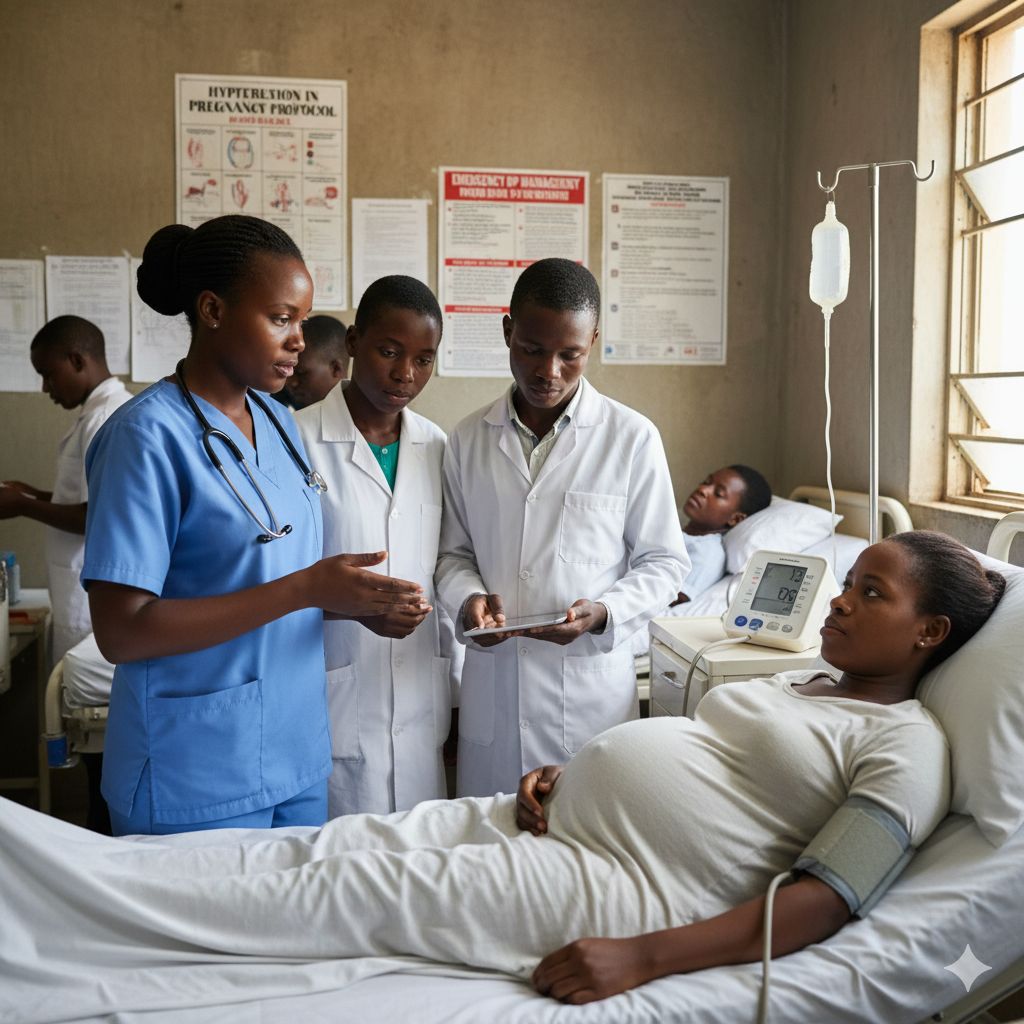
Arwa Adamjee: Hypertension Emergencies and Hypertension in Pregnancy: A Bedside Teaching Note
Arwa Adamjee, Cardiology Fellow at Jakaya Kikwete Cardiac Institute, shared a post on LinkedIn:
“Hypertension Emergencies & Hypertension in Pregnancy: A Bedside Teaching Note
Hypertension remains the leading reversible cause of preventable cardiovascular mortality worldwide.
Yet, in the emergency unit, the distinction between urgency and emergency is often blurred — a delay in recognition can be fatal.
- Hypertensive Emergencies
Defined as severe BP ≥180/120 mmHg with evidence of acute target organ damage (e.g., encephalopathy, pulmonary edema, ACS, AKI, aortic dissection).
Key principle: Lower BP carefully, not quickly. Rapid drops may precipitate ischemia.
Management pearls:
– Admit to a high-dependency or ICU setting.
– Use IV agents with rapid titratability — labetalol, nicardipine, sodium nitroprusside (depending on setting).
– Aim to reduce MAP by ≤25% within the first hour, then to 160/100 mmHg over the next 2–6 hours (ESC 2024 guidelines).
– Avoid sublingual nifedipine — linked to ischemic complications.
Common causes at the bedside: uncontrolled chronic HTN, medication non-adherence, renal disease, or pregnancy-related hypertensive disorders.
2. Hypertension in Pregnancy
A unique clinical spectrum — from gestational HTN to preeclampsia/eclampsia — where two lives depend on every decision.
Mechanism: Placental dysfunction → endothelial injury → systemic vasoconstriction and capillary leak.
This drives multi-organ risk — HELLP, pulmonary edema, eclampsia, stroke.
Treatment priorities:
– Severe HTN (≥160/110 mmHg) requires immediate but controlled lowering.
– First-line agents: IV labetalol, hydralazine, or oral nifedipine.
– Magnesium sulfate for seizure prophylaxis in preeclampsia/eclampsia.
– Definitive treatment: Delivery — timed to maternal-fetal stability and gestational age.
Bedside Takeaways
- Differentiate hypertensive emergency vs. urgency early — look for organ dysfunction.
- Titrate slowly; never normalize BP abruptly.
- In pregnancy, stabilize the mother first — she is the best incubator for the fetus.
- After crisis control, address adherence, comorbidities, and secondary causes (renal, endocrine).
In Tanzania and across LMICs
Resource constraints amplify risk — delayed presentation, limited ICU access, and underuse of parenteral agents.
Strengthening emergency protocols and clinician training can significantly reduce maternal and cardiovascular mortality.
For clinicians: every elevated BP reading in the ED deserves context, caution, and curiosity.
How does your unit differentiate and manage hypertensive emergencies?”

Stay updated with Hemostasis Today.
-
Nov 3, 2025, 08:23The 1st Participant in A New CHECK-NIRS Clinical Study is Enrolled!
-
Nov 3, 2025, 08:15Bert van Meurs Shares the New Late-breaking Results from the iMODERN Trial
-
Nov 3, 2025, 07:10Lisa Shea Shares Key Takeaways from NORD Summit 2025
-
Nov 3, 2025, 06:49Darshan Doshi on Results of iMODERN and ILIAS ANOCA Studies Presented at TCT 2025
-
Nov 2, 2025, 14:172019 ESC/EAS Guidelines for the Management of Dyslipidaemias Discussion with Lale Tokgözoğlu and Jeanine Roeters van Lennep
-
Nov 3, 2025, 09:13Claudio Carrubba on How Timing Truly Matters in Trauma Embolization
-
Nov 3, 2025, 08:46Rachel Lamerton and Colleagues on Activation of Platelets in Flow Cytometry
-
Nov 3, 2025, 04:56Nirupama Ramadas and Erica Sparkenbaugh on Thromboinflammation in SCD
-
Nov 2, 2025, 14:21Claude Franceschi: I Advise You to Understand the Hemodynamic Pathophysiology of Venous Diseases Rather than Blindly Applying Ablation Techniques or Venous Stent Placement
-
Nov 2, 2025, 14:15Krishna Aragam: Why are (DCM) and Heart Failure About Twice as Common in Individuals of Self-Identified Black Race?
-
Oct 29, 2025, 07:31The Use of Artificial Intelligence to Improve Detection of Acute Incidental Pulmonary Emboli - JTH
-
Oct 29, 2025, 07:05Shrinidhi Nathany: AI in Diagnostic Medicine
-
Oct 28, 2025, 07:02Aya Berman: AI Model for Predicting Bacteremia
-
Oct 28, 2025, 06:55The New Era of Genomics, AI and Cell Therapy in Hematology and Infectious Diseases
-
Oct 28, 2025, 06:49Lukas Gaats: Researchers Are Building Reproductive Organoids
-
Nov 3, 2025, 09:24Stephen Cornelissen: It’s Not Just About Emergencies — It’s About Everyday Care, Chronic Conditions and Hope
-
Nov 3, 2025, 06:57Maria Elisa Mancuso Reflects on 2025 Annual Congress of the Italian Association of Hemophilia Centres
-
Nov 3, 2025, 05:46Chandra Viswanathan: When Blood Safety Fails, We All Bleed - A Call for Reform and Responsibility
-
Nov 2, 2025, 14:17Anamaria B: Your Mother Still Runs Part of Your DNA
-
Nov 2, 2025, 10:57Paul Bolaji on Launching The First Centralised Nigerian National Stroke Registry
